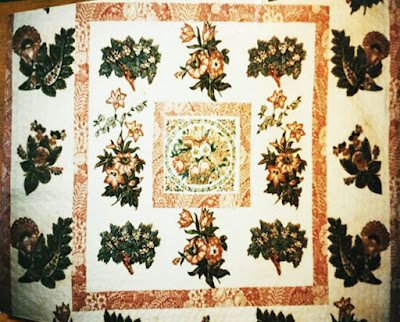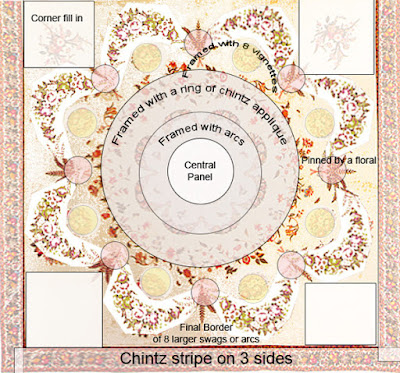Panel #6
A small rectangle with an oval ring framing a wicker basket full of flowers,
including a pair of white primroses in the center. The picture is from
the center of a crib quilt in Polly Mello's collection.
Trimmed, it's the perfect Broderie Perse shortcut.
As in this top from the Historic Columbia Foundation in South Carolina with
panel #2 in the center.
Historic Columbia has two bedcovers with Panel #6.
All we have of this one is a photo of a photocopy....
The piece has 12 examples of Panel #12
The pair of white flowers catches your eye and we've found it in 15 quilts.
Primroses or Aucricula were a popular bloom in
early-19th-century England.
Collection of the Charleston Museum
Panels 3, 5 and 6 (on the north/south points) framed by a stripe of large tropical birds.
Another South Carolina quilt top, this one attributed to Hannah Noland Henderson. She died in 1890 and is buried in Pomaria, Newberry County, South Carolina, near the Broad River northwest of Columbia.
The butterflies are probably cut from Panel #32
and that floating oval lozenge shape is cut from this stripe also
seen in several Carolina chintz quilts
Quilt with inscription "Sally Roxana Caldwell 1833" on the reverse.
She lived in Charlotte, North Carolina.
Collection of the Mint Museum.
See a post about Sarah Roxana Caldwell here:
http://civilwarquilts.blogspot.com/2018/10/the-caldwells-hard-shell-secessionists.html
http://civilwarquilts.blogspot.com/2018/10/the-caldwells-hard-shell-secessionists.html
The inner border is strips of the panel fabric, showing the repeat,
which seems to be the standard way of printing the panels. We
don't know how many panels appeared across the width.
One of four chintz applique quilts attributed to
Ann Adeline Orr Parks (1803-1835), also of Charlotte,
documented in the North Carolina project
The central panel is the fruit basket #5.
Four copies of a trimmed Panel #6 are in the corners
These two quilts from Charlotte are attributed to women of approximately the same age whose husbands were of the same political circles and economic class. Parks was a store owner; Caldwell a doctor.
See a post about the Parks family here:
http://womensworkquilts.blogspot.com/2018/12/ann-adeline-orr-parks-family-in-fabric.html
Panel #6 is the central feature of a beautiful quilt
that descended in the Bull family, confiscated during the Civil War
when Union troops under General Wm. T. Sherman marched in Georgia
and the Carolinas.
Quilt attributed to the Lillington family, perhaps
Pender County, North Carolina.
The trimmed basket is in the center of this one documented in the North Carolina project. We don't see too many Southern panel quilts with cut out corners.
Two copies of panel #6 in a supporting role to the larger panel #2
We don't know much about this quilt from a Skinner auction.
Or about this one in the collection of the Atlanta History Center.
And nothing about this one with four trimmed oval panels framing the center.
We can guess it's a Carolina quilt, however.
That is, unless it's from Baltimore.
In his 1945 book William Rush Dunton showed three closely related, unfinished bedcovers
from different Maryland families.
Each has 8 copies of Panel #6 framed by arcs
The Lassotovich quilt in Dunton's Plate 73
was loaned by a great-granddaughter to the
Baltimore Museum of Art where a color photo was taken.
These remarkably similar quilts still mystify quilt historians.
In her 2018 paper "The Chintz Gardens of Achsah Goodwin Wilkins" for the American Quilt Study Group Ronda Harrell McAllen discussed research into the Goodwin and Wilkins family and the quilts attributed to them. She found that family members left inventories with their wills indicating the family had 72 quilts in their possession at the time the wills were read---"extraordinary, even for very wealthy families...."
Colonial Williamsburg curators Linda Eaton (left) and Kim Ivey discussing
a related Baltimore piece with Ronda (right).
This crib quilt is in Polly Mello's collection (see the top of the page). It's 32 1/2" x 36 3/4".
The style not quite so distinctive that we can link it to a region.
And one last quilt. Our only example that looks to be British
by style---all those hexagons.
We found it pictured in the book Quilts Around the World.
Here's a preview of the book:
What We've Learned from Panel # 6
Our guess is the Baltimore quilts were made by professional seamstresses (free or enslaved) to formula constructions in connection with stores selling fabrics, the same business model we propose for the Carolina quilts. Someone (more than one someone) had a good deal of chintz panel fabric, a fashionable design sense and a crew of skillful needlewomen.
An imaginary sewing factory in Charleston with the standard medallion model
in sight.
A Baltimore Formula
More complex with more variety in the chintzes and a lot more
needlework.
Here are a few other spreads from Dr. Dunton's book based on the same
general formula but using different panels and chintzes
Unfinished. Perhaps you could buy these tops basted.
This one, one of two from the Glenn family, is
missing 6 of the large swags.
The Adams-Coffyn family had two of these spreads in 1945.
This chintz applique was recently donated
to the DAR Museum by the Volckening family. A photo from Bill's blog.
Fits the formula perfectly
Now that we have a pattern all we need is a lot of chintz swags.





































I hope you are having as much fun with this blog as I am. Thank you, thank you, thank you!
ReplyDelete